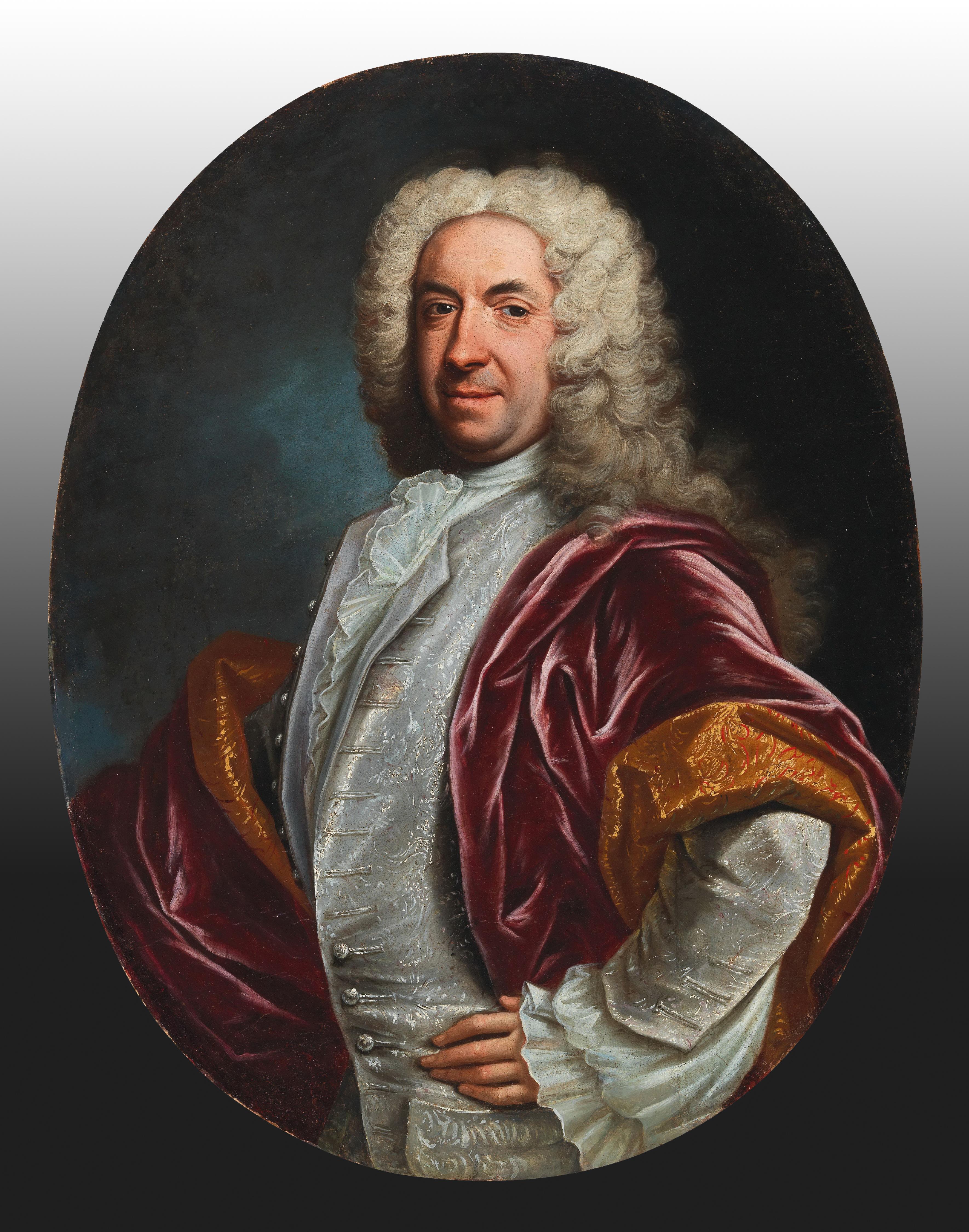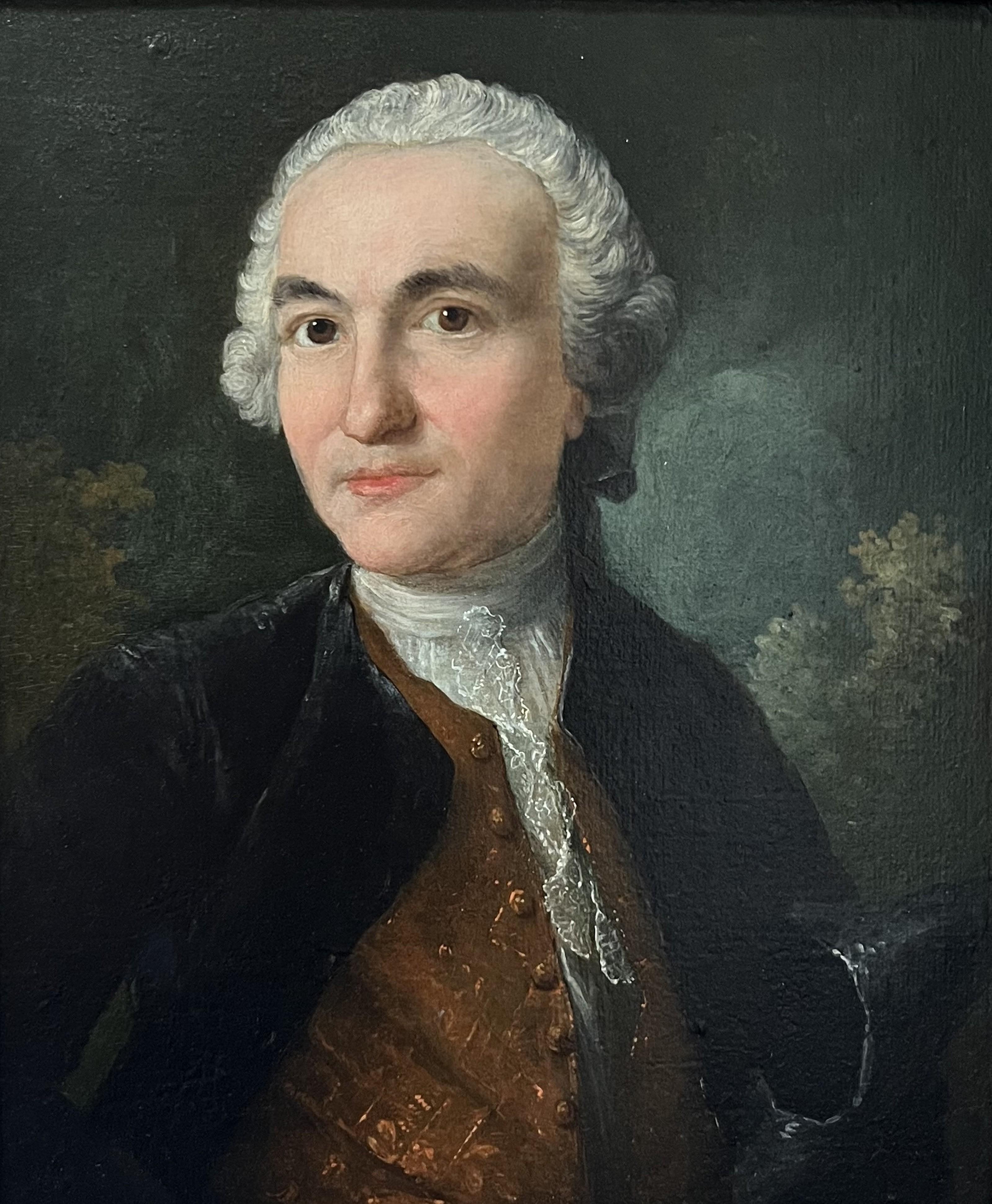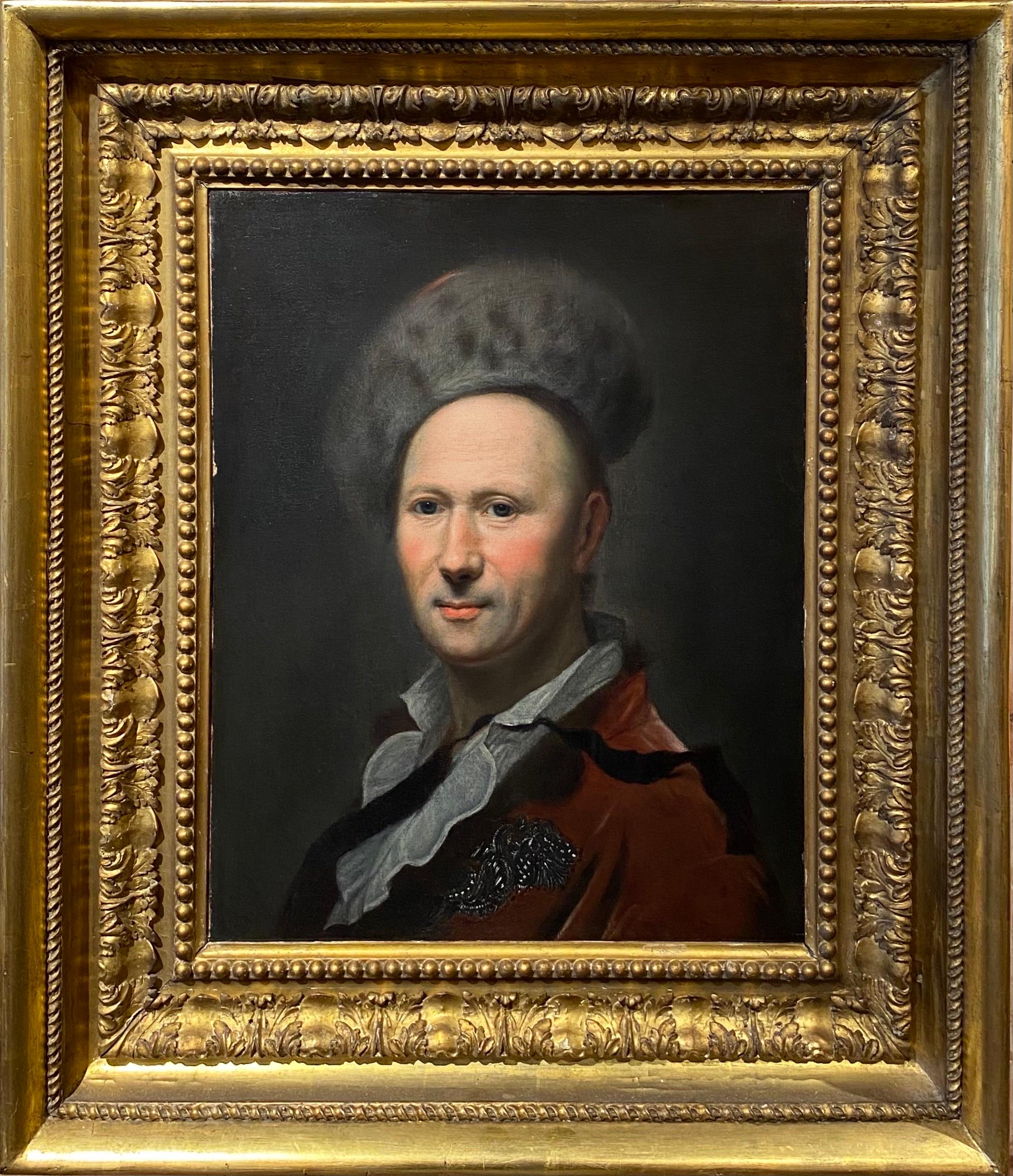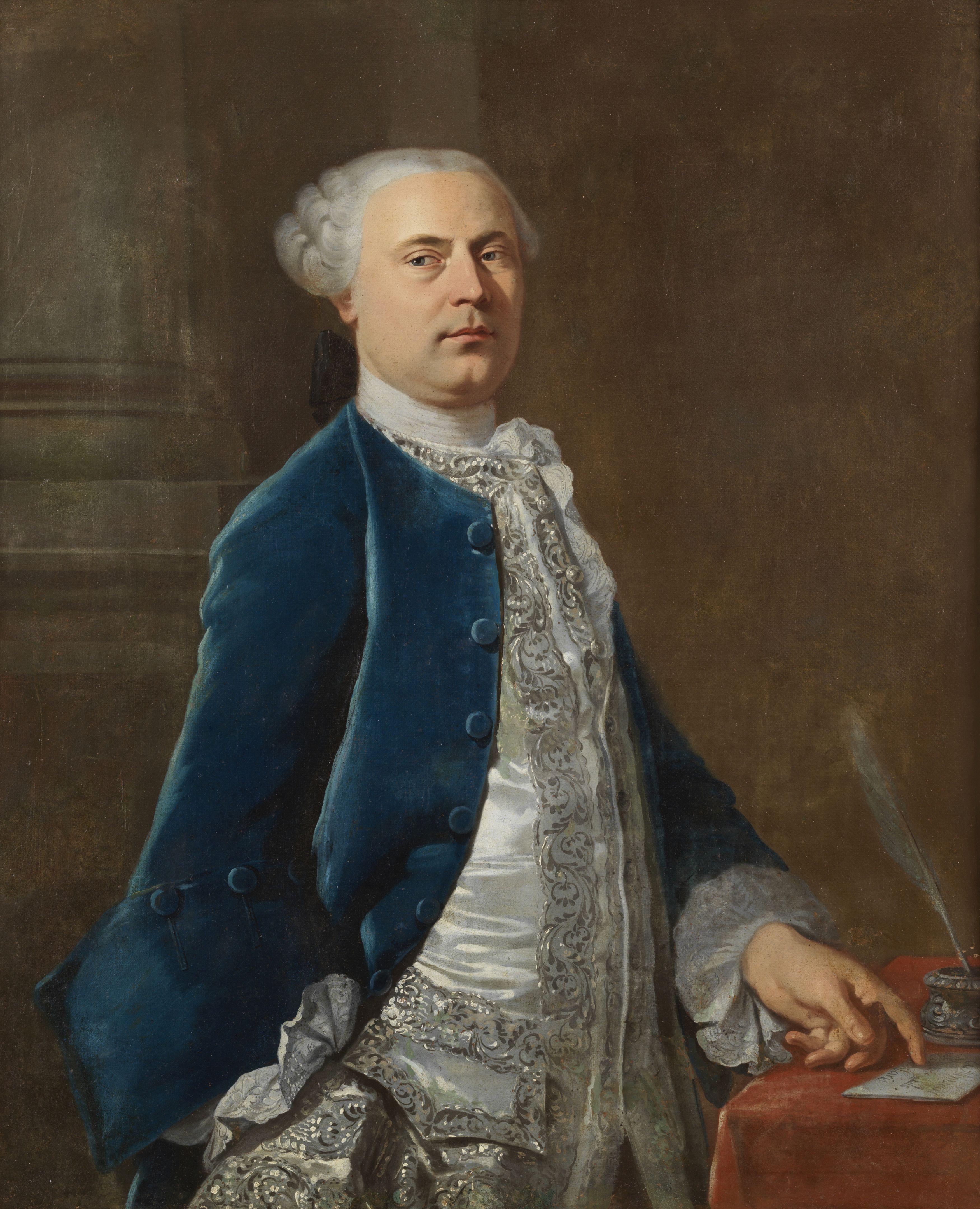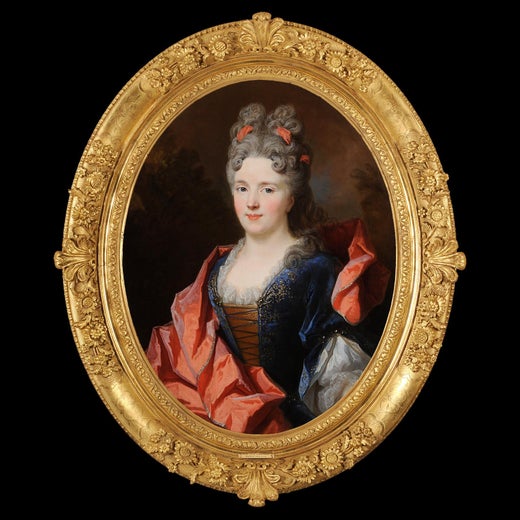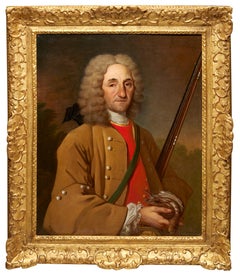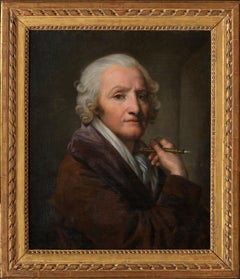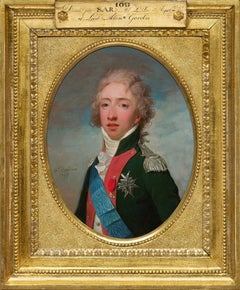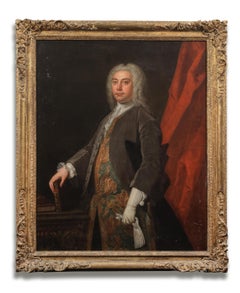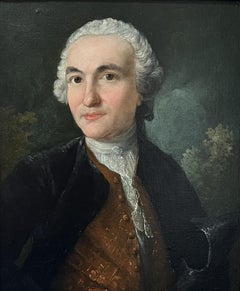Items Similar to Portrait of Monsieur Aubert, a ceremonial portrait by Nicolas de Largillière
Video Loading
Want more images or videos?
Request additional images or videos from the seller
1 of 13
Nicolas de LargillièrePortrait of Monsieur Aubert, a ceremonial portrait by Nicolas de Largillière1725-1730
1725-1730
$141,972.30
£107,922.66
€120,000
CA$199,520.77
A$216,983.37
CHF 114,311.70
MX$2,635,304.06
NOK 1,437,128.82
SEK 1,347,192.21
DKK 918,944.12
About the Item
Provenance :
Arnold S. Kirkeby (1901-1962)
Donated by Arnold S. Kirkeby to the Los Angeles County Museum of Art in 1955, where it remained until its sale at Sotheby's, New York on January 10, 1991, lot 82.
Christie's, London, July 7, 2010, lot 186, where it was purchased after the sale by the executors of the will of the late Edmund de Rothschild (1916-2009) for display at Exbury House
The Trustees of Exbury House
Literature :
R. Brown, Bulletin of the Art Division, Los Angeles County Museum, VIII, 1957, pp.8-9, no. 4;
S. Schaefer and P. Husco, European Paintings and Sculpture in the Los Angeles County Museum of Art (Los Angeles, 1987), p. 53 (illustrated and dated c. 1735)
This sumptuous ceremonial portrait, executed around 1725-1730, depicts Monsieur Aubert, the French General Comptroller of Bridges and Roadways, as we learn from a letter on the desk beside our model. The virtuoso treatment of the fabrics, the authoritative yet confident pose, the vigorous treatment of the two hands, are representative of Largillière's talent, here at the peak of his art as portraitist.
The portrait also has a rather extraordinary provenance: donated by Arnold S. Kirkeby, an American hotel magnate and real estate developer, it was exhibited during almost forty years in the collections of the Los Angeles County Museum, before being acquired in 2010 by the executors of Edmund de Rothschild's will to adorn his former home Exbury House (Hampshire), where it remained until its sale in 2022.
1. Nicolas de Largillière, a great European portraitist
Nicolas de Largillière (or Largillierre), one of Europe's premier painters of portraits, history paintings, and still lifes during the late seventeenth century and the first four decades of the eighteenth, was born in Paris in 1656. He was the son of a hatmaker and merchant who moved with his family to Antwerp in 1659. As a boy of nine, he traveled for the first time to London in the company of an associate of his father. After returning to Antwerp more than a year later, his artistic gifts were recognized and his father apprenticed him to Antoni Goubau (1616-1698), a painter genre scenes and landscapes. Something of a prodigy, he was admitted to the painters' Guild of Saint Luke when he was only seventeen. In 1675 he made a second trip to London, where he was employed at Windsor Castle and worked as a restorer under the direction of Italian painter and decorator Antonio Verrio (c. 1639-1707), who brought him to the attention of King Charles II (r. 1660-1685).
At this time Largillière painted several still life paintings in the manner of the Dutch and Flemish masters. Thereafter he practiced this branch of painting with consummate skill, a talent that allowed him to make brilliant use of flowers, fruit, and animals in some of his most ambitious portraits and contemporary history pictures.
In 1679 Largillière settled in Paris, where he specialized in baroque portraiture in the grand manner of Peter Paul Rubens (1577-1640), Anthony van Dyck (1599-1641), and Peter Lely (1618-1680). The Flemish battle painter Adam Frans van der Meulen (1631 or 1632-1690) introduced him to Charles Le Brun (1619-1690) who, as First Painter to King Louis XIV (r. 1643-1715) and director of the Académie royale de peinture et de sculpture, was the predominant figure in France's official art establishment. Upon his acceptance as a candidate for admission to the Académie, he agreed to execute as his diploma picture a large portrait of Le Brun (completed 1686, Paris, Musée du Louvre, eight photo in the gallery) seated in his studio surrounded by the accoutrements of his art and an oil study for the ceiling of Galerie des Glaces at Versailles.
In 1686, Largillière made a final trip to England, where he painted portraits of the newly crowned king, James II (r. 1685-1688) (Greenwich, National Maritime Museum) and his consort Mary of Modena (1658-1718). After the Glorious Revolution, James fell from power, fled to France, and took up residence near Paris at the old Château de Saint-Germain-en-Laye. For many years thereafter, Largillière was employed as one of the principal portraitists of the Jacobite court.
In 1699, Largillière married Marguerite Élisabeth Forest, and the couple had three children. He continued to produce moving religious paintings and still, but he acquired his enormous reputation primarily as a portraitist. In contrast to his contemporary Hyacinthe Rigaud (1659-1743), however, he was seldom patronized by the court of Versailles, and much of his clientele was made up of government officials, members of the high clergy, municipal leadership, and judiciary, the Parisian and provincial aristocracy, the wealthiest echelons of the middle class, artists, and foreign dignitaries.
In Largillière's portraiture, subjects are elegantly integrated into indoor or outdoor settings, and the artist often relies on mythological disguises, flurries of drapery, and flamboyant poses to dramatize his characterizations of them. Much of the beauty of his painting resides in a daring exploitation of the resonant colors of his palette, for Largillière belonged to that group of painters and theorists led by Roger de Piles (1635-1709) who championed the notion that the sensual appeal of color was equal in importance to the more intellectual emphasis on line and design in the creative act of painting.
Although Largillière is known to have produced oil sketches of sitters' faces and hands and studies for his contemporary history pictures, he painted his portraits quickly and directly onto canvas with little or no preparation, relying on scumbles and transparent glazes to achieve the rich and sonorous effects he sought. His enormous output - some 1,500 portraits that are currently being catalogued by Dominique Brême - required him to maintain a workshop manned with studio assistants to whom he delegated the painting of costumes and minor accessories. In the course of his long career he amassed a large fortune and lived on a grand scale. The venerable artist, who had trained Jean Baptiste Oudry (1686-1755) and was prescient enough to appreciate the genius of Jean Siméon Chardin (1699-1779), died in 1746 at the age of ninety, having served terms as professor, rector, chancellor, and director of the Académie royale.
Largillière dominated French portrait painting well into his old age: born in 1656, he painted his last portrait in 1741 (at the age of 85). Around 1730, when he was already over 70 years old, he still showed himself to be capable of a singular verve and freshness: the solid framework of his compositions, the assured drawing of his hands, the refined modeling of his complexions and the admirable rendering of fabrics found in the ceremonial portraits of this period are proof of a firm mind, an exceptionally keen eye and a genius that remained intact.
2. Some bibliographical information on the model
We have been able to find out a little about the life of Jean Aubert, who lived in Paris, in the Hôtel de Beringhen on rue Saint-Nicaise, a street that no longer exists near the Palais des Tuileries, in the parish of Saint-Germain-l'Auxerrois.
He also owned a house at 18 rue Grande in La Chapelle, a neighboring commune to the north of Paris, on the road to Saint-Denis (this commune was incorporated into Paris in 1860).
Probably born in the late 17th century, Jean Aubert married Marie Catherine Marchand (who died in 1745) around 1725. Originally from Fontainebleau, she was the daughter of a paving contractor to the King and the sister of a contractor to the King's Ponts et Chaussées.
They had several children:
• Adrien Aubert
• Henry Camille Aubert (de la Tombelle)
• Nicolas Jean Claude Aubert (de Blaumont)
• Marie Rosalie Aubert
• Jean Jacques Aubert (de la Pernelière)
• Jean Etienne Aubert who died aged 3 in 1728 in the parish of Saint-Louis in Versailles.
His children were subsequently the King’s pensioners, in recognition of the services rendered by their late father.
Although we have found no information on his family origins, Jean Aubert seems to have belonged to a Parisian bourgeoisie family, and to have had a small fortune which enabled him to successively acquire the position of treasurer of the Menus-Plaisirs de la Petite Écurie du Roi, then, around 1728-1730, that of King's Counselor and General Comptroller of Bridges and Roadways. It seems likely that this ceremonial portrait was commissioned shortly afterwards to celebrate the acquisition of this position.
3. Description of the portrait
Draped in a scarlet cloak almost reminiscent of imperial purple, Jean Aubert is depicted in a green suit, wearing a powdered wig (traces of powder can be seen on the edge of his jacket, at shoulder level), sword at his side. In a setting of austere grandeur, punctuated by columns, the traditional attributes of strength, he stands facing us.
Largillière's talent lies in his daring presentation of a veritable chromatic explosion in the illusionist treatment of shimmering fabrics (brilliant red on the coat, enhanced by eau-du-Nil highlights on the lapel, saffron yellow on the vest and the sleeves of his jacket). These vibrant colors are set off by the muted tones with which they contrast: the gray of the background, the dark green of the jacket, and the black of the desk and wallet.
In our opinion, one of the most virtuoso parts of this portrait is the still life on the desk in the lower left-hand corner. In a skillful disarray, Largillière brings together various attributes of intellectual life: a few books, an inkwell and a silver bell, partly hidden by a letter, a quill and a wax stick, an open wallet. The chromatic range is exclusively in whites and blacks, enhanced by a few touches of red (the stick of wax, the ribbons on the documents located inside the wallet). The treatment of the objects (books, silver inkwell in which the wax stick is reflected) recalls certain compositions by the young Chardin.
Monsieur Aubert's ungloved right hand seems to be pointing to the letter addressed to him which indicates his position. It seems to us that the quill resting on the inkwell might suggest that the ink is barely dry, as if to confirm that this painting was indeed commissioned to celebrate his accession to this prestigious position.
Just as his right hand seemed supple and abandoned, his left hand, still gloved, energetically grips the second glove, as if to indicate the model's fierce energy and unyielding determination beneath his debonair appearance.
In conclusion, the psychological treatment of our "bourgeois gentilhomme" in this portrait seems to us highly successful: the model's corpulence (visible, for example, in the shirt protruding from the half-open vest) becomes an attribute of his social success, and Largillière succeeds in conferring on this face without any particular grace a great humanity that makes this character sympathetic.
4. Some of Largillière's ceremonial portraits from 1725-1730
Three ceremonial portraits by Largillière, executed between 1724 and 1730, bear interesting similarities to Monsieur Aubert's portrait, particularly if you look at the models' hands.
While Monsieur Aubert's right hand is very similar to that of Konrad Detlef (Herzog Anton Ulrich Museum - Brünswick – Germany, ninth photo in the gallery), his gloved left hand is reminiscent of Barthélemy Jean-Claude Pupil’s portrait (Putnam Foundation, Timken Museum of Art - San Diego - California – USA – 10th photo in the gallery). In this 1729 portrait, we find more generally a great similarity in the overall attitude of the model, but also in the inclusion of a ledger on the model's right.
This opposition between the ungloved right hand and the gloved left hand is a recurrent topos in Largillière's men portraits from this period, as illustrated by the portrait of Sir Robert Throckmorton (Coughton Court - National Trust - United Kingdom – last photo in the gallery).
5. Framing
Our painting is framed in a sumptuous Louis XV period rocaille-style frame. Executed in carved and gilded wood, it features pierced cartouches adorned with shells and pear-shaped cabochons, and flowering branches.
Some bibliographical references :
Catalogue de l’Exposition Largillière – Palais des Beaux-Arts de la Ville de Paris (Petit Palais) 1928
Catalogue de l’exposition Nicolas de Largillière (1656-1746) – Musée Jacquemart-André Paris
Largillière portraitiste du dix-huitième siècle – Musée des Beaux-Arts de Montréal 1981
- Creator:Nicolas de Largillière (1656 - 1746, French)
- Creation Year:1725-1730
- Dimensions:Height: 64.57 in (164.01 cm)Width: 52.57 in (133.53 cm)
- Medium:
- Movement & Style:
- Period:1720-1729
- Condition:Unframed size : 134.5 x 103 cm (53'' x 40 ½'').
- Gallery Location:PARIS, FR
- Reference Number:1stDibs: LU1568213419082
Nicolas de Largillière
Nicolas de Largilliere (Paris, 1656-1746) Born in Paris, Nicolas de Largilliere spent his childhood in Antwerp. Trained there in the studio of Antoine Goubeau, who taught him the study from nature, Nicolas de Largillierre remained faithful to his precepts throughout his career. In 1673 he went to England where he worked as an assistant in the studio of the portrait painter Peter Lely for almost seven years. He was approved by the Royal Academy upon his return to France in 1683 and was received three years later as "painter of portraits and history"). The portrait is by far the genre that dominates an immense production of nearly 1,500 works produced in a workshop through which many renowned painters will pass. He is with Rigaud the most brilliant portraitist of the end of the XVIIth and the beginning of the XVIIIth century. Rigaud, however, is the official court portraitist, Largillierre works mainly for a wealthy bourgeois clientele. His work brilliantly illustrates the French high society under the reigns of Louis XIV and Louis XV, by an exceptional sense of observation he was able to render, sometimes without complacency, the individuality of the faces and the psychology of the characters.
About the Seller
5.0
Vetted Professional Seller
Every seller passes strict standards for authenticity and reliability
Established in 2020
1stDibs seller since 2021
10 sales on 1stDibs
- ShippingRetrieving quote...Shipping from: PARIS, France
- Return Policy
Authenticity Guarantee
In the unlikely event there’s an issue with an item’s authenticity, contact us within 1 year for a full refund. DetailsMoney-Back Guarantee
If your item is not as described, is damaged in transit, or does not arrive, contact us within 7 days for a full refund. Details24-Hour Cancellation
You have a 24-hour grace period in which to reconsider your purchase, with no questions asked.Vetted Professional Sellers
Our world-class sellers must adhere to strict standards for service and quality, maintaining the integrity of our listings.Price-Match Guarantee
If you find that a seller listed the same item for a lower price elsewhere, we’ll match it.Trusted Global Delivery
Our best-in-class carrier network provides specialized shipping options worldwide, including custom delivery.More From This Seller
View AllPortrait of Julien Prieur the bailiff of the Marquis d'Armentières as a Hunter
By Jean-Baptiste Oudry
Located in PARIS, FR
This portrait depicts us the trusted confidant of the Conflans d'Armentières family. More precisely, Julien Prieur was the fiscal procurator of the Marquisate of Armentières, playing...
Category
1730s Old Masters Portrait Paintings
Materials
Canvas, Oil
A replica of the JB Greuze's last self-portrait, by his daughter Anne-Geneviève
Located in PARIS, FR
While the Petit-Palais is hosting the first exhibition dedicated to the artist in Paris in over a century, this replica of the last painting by Jean-Baptiste Greuze, executed by his ...
Category
Early 1800s Old Masters Portrait Paintings
Materials
Canvas, Oil
Portrait of Senator Bartolomeo Panciatichi by Santi di Tito (1574)
Located in PARIS, FR
This recently rediscovered portrait of Santi di Tito depicts a Florentine senator, with a letter in his hand indicating that the painting was executed in 1574 when the sitter was 66 years old. On the basis of these clues, it is tempting to view it as a portrait of Bartolomeo Panciatichi, who was painted some thirty years before by Bronzino (1503 - 1572). While the treatment of the hands recalls the Florentine tradition of Mannerist portraits, the comparison with Bronzino's portrait illustrates Santi di Tito's search for greater realism, despite the stereotyped composition.
1. Santi di Tito, Counter-Reformation painter and portraitist
Santi di Tito was the great painter of the Florentine Counter-Reformation. He proposed a new artistic language that broke away from Mannerism.
Little is known about his training in Florence (perhaps alongside Bronzino or Baccio Bandinelli), but this period of training enabled him to join the Company of Saint Luke, the guild of Florentine painters, in 1554. Between 1560 and 1564, Santi di Tito spent time in Rome, where he frequented the workshop of Taddeo Zuccari. This stay had a fundamental influence on his work, thanks to the discovery of the late work of Raphael, but also his encounters with the painters Francesco Salviati and Federico Barocci.
Around 1565, Santi di Tito returned to Florence, where he remained until the end of his life, dividing his talents between the creation of important religious paintings and countless portraits. He became one of the city's leading painters, distinguishing himself, in particular, in the creation of large religious compositions in which the spirit of the Counter-Reformation was reflected.
In 1568, Santi di Tito became a member of the Confraternity of Saint Thomas Aquinas...
Category
16th Century Old Masters Portrait Paintings
Materials
Poplar, Oil
Two royal portraits (the Duc d'Angoulême and the Duc de Berry) by H.P. Danloux
Located in PARIS, FR
These two royal portraits are a major historical testimony to the stay of the Comte d'Artois (the future Charles X) and his family in Edinburgh in 1796-1797. Given by the sitters to Lord Adam Gordon, the Governor of Edinburgh, and kept by family descent to this day, these two portraits provide us with a vivid and spontaneous image of the Duc d’Angoulême and his brother the Duc de Berry. Danloux, who had emigrated to London a few years before, demonstrate his full assimilation of the art of British portrait painters in the brilliant execution of these portraits.
1. Henri-Pierre Danloux, a portraitist in the revolutionary turmoil
Born in Paris in 1753, Henri-Pierre Danloux was first a pupil of the painter Nicolas-Bernard Lépicié (1735 - 1784) and then, in 1773, of Joseph-Marie Vien (1716 - 1809), whom he followed to Rome when, at the end of 1775, Vien became Director of the Académie de France. In Rome he became friends with the painter Jacques-Louis David (1748 - 1825).
Returning to France around 1782, he settled in Lyon for a few years before returning to Paris in 1785. One of his first portraits was commissioned by the Baroness d'Etigny, the widow of the former Intendant of the Provinces of Gascony, Bearn and Navarre Antoine Mégret d'Etigny (1719 – 1767). He then became close to his two sons, Mégret de Sérilly and Mégret d'Etigny, who in turn became his patrons. In 1787, this close relationship with the d'Etigny family was further strengthened by his marriage to Antoinette de Saint-Redan, a relative of Madame d'Etigny. After his marriage, he left for Rome and did not return to France until 1789. It was during the winter of 1790-1791 that he painted one of his masterpieces, the portrait of Baron de Besenval. Set in a twilight atmosphere, this portrait of an aristocrat who knows that his death is imminent symbolizes the disappearance of an erudite and refined society which would be swept away by the French Revolution.
The Jacobin excesses led Danloux to emigrate to England in 1792; many members of his family-in-law who remained in France were guillotined on 10 May 1794. Danloux enjoyed great success as a portrait painter in England before returning to France in 1801.
During his stay in England, Danloux was deeply under the influence of English portraitists: his colors became warmer (as shown by the portrait of the Duc d'Angoulême that we are presenting), and his execution broader.
2. Description of the two portraits and biographical details of the sitters
The Duc d'Angoulême (1775-1844) was the eldest son of the Comte d'Artois, the younger brother of King Louis XVI (the future King Charles X), and his wife Marie-Thérèse of Savoie. He is shown here, in the freshness of his youth, wearing the uniform of colonel-general of the "Angoulême-Dragons" regiment.
He is wearing the blue cordon of the Order of the Holy Spirit, which was awarded to him in 1787, and two decorations: the Cross of Saint-Louis and the Maltese Cross, as he was also Grand Prior of the Order of Malta.
Born on 16 August 1775 in Versailles, Louis-Antoine d'Artois followed his parents into emigration on 16 July 1789. In 1792, he joined the émigrés’ army led by the Prince de Condé. After his stay in Edinburgh (which will be further discussed), he went to the court of the future King Louis XVIII, who was in exile at the time, and in 1799 married his first cousin Marie-Thérèse Charlotte of France, the daughter of Louis XVI and the sole survivor of the royal family. The couple had no descendants. He became Dauphin of France in 1824, upon the accession to the throne of his father but played only a minor political role, preferring his military position as Grand Admiral. Enlisted in Spain on the side of Ferdinand VII, he returned home crowned with glory after his victory at Trocadero in 1823.
He reigned for a very short time at the abdication of Charles X in 1830, before relinquishing his rights in favor of his nephew Henri d'Artois, the Duc de Bordeaux. He then followed his father into exile and died on 3 June 1844 in Gorizia (now in Italy).
His younger brother, the Duc de Berry, is shown in the uniform of the noble cavalry of the émigrés’ Army. He is wearing the blue cordon of the Order of the Holy Spirit, awarded to him in May 1789, and the Cross of Saint-Louis (partly hidden by his blue cordon).
Born on 24 January 1778 in Versailles, Charles-Ferdinand d'Artois also followed his parents into emigration and joined the émigrés’ army in 1792. After his stay in Edinburgh, he remained in Great Britain, where he had an affair with Amy Brown...
Category
1790s Old Masters Portrait Paintings
Materials
Canvas, Oil, Wood Panel
Portrait of an Ottoman Dignitary, a drawing by Giuseppe Nogari (ca. 1760)
Located in PARIS, FR
We would like to thank Mrs. Bozena Anna Kowalczyk for confirming the attribution of this drawing to Giuseppe Nogari in a study (available in Italian) from which we have taken our ins...
Category
1760s Old Masters Portrait Drawings and Watercolors
Materials
Laid Paper, Chalk
Allegory of the Treaty of Angoulême, a drawing attributed to Donato Mascagni
Located in PARIS, FR
We would like to thank Mrs. Ursula Verena Fischer Pace for suggesting the attribution to Donato Arsenio Mascagni.
We were immediately seduced by the rich tonalities of this allegory...
Category
1620s Old Masters Figurative Drawings and Watercolors
Materials
Ink
You May Also Like
Baroque Portrait of a gentleman 18th century Italian master by Domenico Parodi
By Domenico Parodi (Genoa, 1672 - 1742)
Located in Stockholm, SE
We are grateful to Prof. Daniele Sanguineti for suggesting the attribution to Domenico Parodi (1672 - 1742). He dates the painting into the period between 1730 and 1740. Domenico Par...
Category
1730s Realist Portrait Paintings
Materials
Canvas, Oil
Portrait of Ralph William Grey
By Bartholomew Dandridge
Located in London, GB
Provenance
By descent through the sitter's family to
The Collection of R. W. Vivian-Neal of Poundisford Park, Somerset, from whom acquired by
With Lane Fine Art, UK, where purchased by the present owners in 1996
Literature
'Poundisford Park, Somerset' in Country Life, 22 December 1934, ill.
A.W. and C.M. Vivian-Neal, Poundisford Park, Somerset: A catalogue of pictures and furniture, Taunton 1939, cat. nos. 11 and 13
This is a three-quarter-length portrait of Ralph William Grey in a mole-coloured velvet coat and a long waistcoat of green satin, heavily embroidered in gold. Under his left right hand is a black chapeau bras. He has white doe-skin gauntlet gloves.
Son of William and Ann Grey of Backworth: born 19 December 1707. He married Mary the daughter of William Rawstorne of Newall in 1741 and died 5 November 1786. He was educated at Eaton and Trinity College, Oxford.
Within a year of his birth Mrs Grey died and, according to the Country Life article 'From that time forward all Mr Grey's faculties were concentrated on the well-being of his son. The possession of an heir gave zest to his efforts to build up the family fortune: he was successful in most of his ventures. Years later his interest in life was centred in the home of his daughter-in-law and grandchildren'.
Grey's right hand is depicted in the present portrait resting on Locke's Essays and the Country Life article also records that there are constant references to John Locke...
Category
Mid-18th Century English School Portrait Paintings
Materials
Oil
Portrait Johann Theodor Bavaria, Son of Prince Elector, by Joseph Vivien, Rococo
By Joseph Vivien
Located in Greven, DE
Portrait of Johann Theodor of Bavaria (1703-1763)
by Joseph Vivien
Johann Theodor of Bavaria (* September 3, 1703 in Munich; † January 27, 1763 in Lièg...
Category
18th Century Rococo Portrait Paintings
Materials
Canvas, Oil
French School 18th century, Portrait of a gentleman, oil
Located in Paris, FR
French School 18th Century
Portrait of a gentleman holding his hat
Oil on paper transferred on wood panel
34 x 27 cm
In a beautiful vintage wood frame with some lacks in the mould
...
Category
1760s Old Masters Portrait Paintings
Materials
Oil
Portrait of Conrad Friedrich Hurlebusch, Early 18th Century Oil Painting
By Dominicus van der Smissen
Located in London, GB
Dominicus van der Smissen
Early 18th Century
Portrait of Conrad Friedrich Hurlebusch
Oil on canvas
Image size: 20½ x 16¼ inches
Period gilt frame
This is a portrait of Conrad Friedrich Hurlebusch, composer, Kapellmeister and organist, whom Van der Smissen most probably portrayed during his stay in Hamburg, Brunswick or Amsterdam. The identification is based on the reproduction of the portrait which was engraved by Pieter Anthony Wakkerdak (1740- 1774).
Van der Smissen has reduced the face of the sitters to an egg-shaped oval in three-quarter view, applying diminution to one half of the figure’s torso, which is farther away from the viewer. This partial side view, with the head turned to look at the viewer over the shoulder, creates spatial depth and brings the figure to life by avoiding the stiffness of a frontal depiction.
Because the artist chose to highlight the figure from above, a distinct shadow is cast under the tip of the nose, in the shape of a triangle. This is an often recurring and almost ‘signature’-like feature in Van der Smissen’s oeuvre.
Hurlebusch's garments are of a very high quality and serve to reflect the sitter’s wealth, status and elegance. During this period, gentlemen often shaved their heads in order to facilitate the wearing of a wig, which wouldbe worn with a suit. Here Hurlebusch has been depicted in a luxurious turban-like cap lined with lynx fur, a highly fashionable and expensive material at the time.
Over his shirt, he wears a velvet fur-lined gown adorned with decorative clasps fashioned from silver braid. The elegant informality of his appearance can be seen in his unbuttoned shirt and the unfastened black ribbon hanging from his button hole, which has been artfully arranged into a fluttering drape by the portraitist.
The Sitter
Hurlebusch was born in Brunswick, Germany. He received the first instructions in his field from his father Heinrich Lorenz Hurlebusch, who was also a musician. As an organ virtuoso, he toured Europe, visiting Vienna, Munich and Italy.
From 1723 to 1725 he was Kapellmeister in Stockholm; later he became Kapellmeister in Bayreuth and Brunswick, and lived in Hamburg from 1727 to 1742, where he had contact with fellow composers Johann Mattheson and Georg Philipp Telemann. He made his living composing, performing and teaching.
In 1735 and 1736, he is believed to have visited Johann Sebastian Bach in Leipzig, who promoted Hurlebusch’s compositions as the local seller...
Category
Early 18th Century Old Masters Portrait Paintings
Materials
Canvas, Oil
18th Century Portrait of a Gentleman French School Man Oil on Canvas Blue White
Located in Sanremo, IT
Painting, oil on canvas, measuring 92 x 75 cm without frame and 102 x 87 cm with frame depicting a nobleman of the French school of the first half of the 18th century.
In its formal...
Category
Early 18th Century French School Portrait Paintings
Materials
Canvas, Oil
